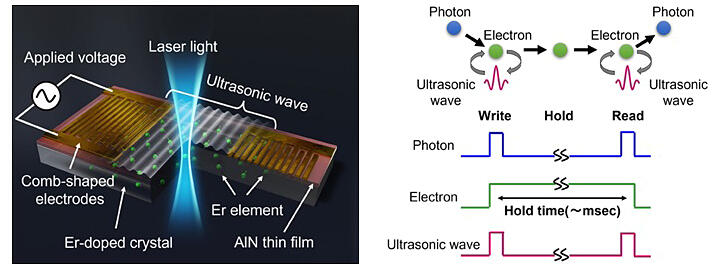NTT and Nihon University have developed an ultrasonic device doped with the rare earth element erbium (Er), which resonates with light at communication wavelengths, and have successfully created a hybrid state of photoexcited electrons with a lifetime of several milliseconds and gigahertz ultrasound wavelength. This achievement facilitates the control of rare-earth electrons with high coherence through low-voltage ultrasonic excitation and is expected to contribute to developing future applications in energy-saving quantum optical memory devices. The results were published online in the U.S. scientific journal, Physical Review Letters.

Provided by NTT
Er, a rare earth element, possesses inner-shell electrons that resonate with light at communication wavelengths. Since inner-shell electrons shielded by outer-shell electrons are insensitive to the outside world, quantum optical memory uses Er as an element that provides high quantum coherence. However, the shielding effect of outer-shell electrons has a drawback, making it challenging to externally control the inner-shell electrons. Traditionally, modulating the optical resonance frequency of Er by 1 GHz in crystals using an electric field has required high voltages exceeding 100 V, presenting a challenge of low controllability.
In response to this issue, NTT is conducting research to develop energy-efficient quantum optical memory devices using a mechanical oscillator capable of achieving significant modulation at low voltages. To achieve this, a major challenge has been the creation of a hybrid state of electrons and vibrations that allows for the control of optical responses of electrons through mechanical vibrations.
In this study, NTT and Nihon University developed a device that generates surface acoustic waves, a type of ultrasound, on an Er-doped crystal substrate. This achievement concentrates approximately 2 GHz of vibrational strain on the crystal surface, enabling successful high-speed modulation of the optical resonance frequency of Er. This modulation speed surpasses the lifetime of the excited electrons, modulating the electrons at a frequency beyond the resonance linewidth, thereby creating a hybrid state of electrons resonating at the communication wavelength band and gigahertz ultrasound. Utilizing this state, the optical response of Er-excited electrons with high coherence can be controlled by ultrasound at low voltage, promising future applications in energy-saving quantum optical memory devices.
This article has been translated by JST with permission from The Science News Ltd. (https://sci-news.co.jp/). Unauthorized reproduction of the article and photographs is prohibited.




